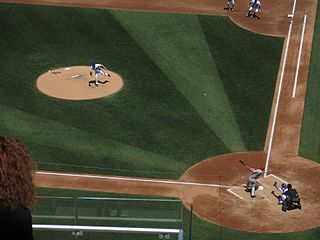
Baseball is a bat-and-ball sport played between two teams of nine players each, taking turns batting and fielding. The game occurs over the course of several plays, with each play generally beginning when a player on the fielding team, called the pitcher, throws a ball that a player on the batting team, called the batter, tries to hit with a bat. The objective of the offensive team is to hit the ball into the field of play, away from the other team's players, allowing its players to run the bases, having them advance counter-clockwise around four bases to score what are called "runs". The objective of the defensive team is to prevent batters from becoming runners, and to prevent runners' advance around the bases. A run is scored when a runner legally advances around the bases in order and touches home plate.

Field hockey is a team sport structured in standard hockey format, in which each team plays with 11 players in total, made up of 10 field players and a goalkeeper. Teams must move a hockey ball around a field by hitting it with a hockey stick towards the rival team's shooting circle and then into the goal. The match is won by the team that scores the most goals. Matches are played on grass, watered turf, artificial turf, or indoor boarded surface.

The long jump is a track and field event in which athletes combine speed, strength and agility in an attempt to leap as far as possible from a takeoff point. Along with the triple jump, the two events that measure jumping for distance as a group are referred to as the "horizontal jumps". This event has a history in the ancient Olympic Games and has been a modern Olympic event for men since the first Olympics in 1896 and for women since 1948.

A magnetic field is a physical field that describes the magnetic influence on moving electric charges, electric currents, and magnetic materials. A moving charge in a magnetic field experiences a force perpendicular to its own velocity and to the magnetic field. A permanent magnet's magnetic field pulls on ferromagnetic materials such as iron, and attracts or repels other magnets. In addition, a nonuniform magnetic field exerts minuscule forces on "nonmagnetic" materials by three other magnetic effects: paramagnetism, diamagnetism, and antiferromagnetism, although these forces are usually so small they can only be detected by laboratory equipment. Magnetic fields surround magnetized materials, electric currents, and electric fields varying in time. Since both strength and direction of a magnetic field may vary with location, it is described mathematically by a function assigning a vector to each point of space, called a vector field.

Athletics is a group of sporting events that involves competitive running, jumping, throwing, and walking. The most common types of athletics competitions are track and field, road running, cross-country running, and racewalking.

The hammer throw is one of the four throwing events in regular outdoor track and field competitions, along with the discus throw, shot put and javelin.

The decathlon is a combined event in athletics consisting of 10 track and field events. The word "decathlon" was formed, in analogy to the word "pentathlon", from Greek δέκα and ἄθλος. Events are held over two consecutive days and the winners are determined by the combined performance in all. Performance is judged on a points system in each event, not by the position achieved. The decathlon is contested mainly by male athletes, while female athletes typically compete in the heptathlon.

Frederick Carlton Lewis is an American former track and field athlete who won nine Olympic gold medals, one Olympic silver medal, and 10 World Championships medals, including eight gold. Lewis was a dominant sprinter and long jumper whose career spanned from 1979 to 1996, when he last won the Olympic long jump. He is one of six athletes to win gold in the same individual event in four consecutive Olympic Games, and is one of two people to win gold in the same individual athletics event in four Olympic Games, along with discus thrower Al Oerter. He is the head track and field coach for the University of Houston.

Florence Delorez Griffith Joyner, also known as Flo-Jo, was an American track and field athlete and the fastest woman ever recorded. She set world records in 1988 for the 100 m and 200 m. During the late 1980s, she became a popular figure due to both her record-setting athleticism and eclectic personal style.

Athletics is a sport that includes athletic contests based on running, jumping, and throwing skills. The name used in North America is derived from where the sport takes place, a running track and a grass field for the throwing and some of the jumping events. Track and field is categorized under the umbrella sport of athletics, which also includes road running, cross country running and racewalking. In British English the term athletics is synonymous with American track and field and includes all jumping events. Outside of Canada and the United States, athletics is the official term for this sport with 'track' and 'field' events being subgroups of athletics events.

Sally Margaret Field is an American actress. Known for her extensive work on screen and stage, she has received many accolades throughout her career spanning five decades, including two Academy Awards, two Golden Globe Awards, and three Primetime Emmy Awards, in addition to nominations for a Tony Award and two British Academy Film Awards. She was presented with a star on the Hollywood Walk of Fame in 2014, the National Medal of Arts in 2014, the Kennedy Center Honor in 2019, and the Screen Actors Guild Life Achievement Award in 2023.

The National Front (NF) is a far-right, fascist political party in the United Kingdom. It is currently led by Tony Martin. A minor party, it has never had its representatives elected to the British or European Parliaments, although it gained a small number of local councillors through defections and it has had a few of its representatives elected to community councils. Founded in 1967, it reached the height of its electoral support during the mid-1970s, when it was briefly England's fourth-largest party in terms of vote share.

Jacqueline Joyner-Kersee is a retired American track and field athlete who competed in both the heptathlon and long jump. She won three gold, one silver, and two bronze Olympic medals at four different Olympic Games. Joyner-Kersee was also a four-time gold medalist at the world championships. Since 1988, she has held the world record for heptathlon.
PubMed is a free database including primarily the MEDLINE database of references and abstracts on life sciences and biomedical topics. The United States National Library of Medicine (NLM) at the National Institutes of Health maintains the database as part of the Entrez system of information retrieval.

Michael Duane Johnson is an American retired sprinter who became Olympic Champion four times, and World Champion eight times in the span of his career. He held the world and Olympic records in the 200 m and 400 m, as well as the world record in the indoor 400 m. He also once held the world's best time in the 300 m. Johnson is generally considered one of the greatest and most consistent sprinters in the history of track and field.

Field hockey was introduced at the Olympic Games as a men's competition at the 1908 Games in London. In the men’s category, India is the most successful team, with 8 Gold, 1 Silver & 4 Bronze medals. But overall, the Netherlands is the most successful country, with 8 Gold, 6 Silvers & 6 Bronze medals. A total of 20 medals across their men's and women's teams.

The 5000 metres or 5000-metre run is a common long-distance running event in track and field, approximately equivalent to 3 miles 188 yards or 16,404 feet 2 inches. It is one of the track events in the Olympic Games and the World Championships in Athletics, run over 12+1⁄2 laps of a standard track. The same distance in road running is called a 5K run; referring to the distance in metres rather than kilometres serves to disambiguate the two events. The 5000 m has been present on the Olympic programme since 1912 for men and since 1996 for women. Prior to 1996, women had competed in an Olympic 3000 metres race since 1984. The 5000 m has been held at each of the World Championships in Athletics in men's competition and since 1995 in women's.

The India men's national field hockey team represents India in international field hockey competitions, and is governed by Hockey India.

Cricket is a bat-and-ball game that is played between two teams of eleven players on a field, at the centre of which is a 22-yard (20-metre) pitch with a wicket at each end, each comprising two bails balanced on three stumps. Two players from the batting team stand in front of either wicket holding bats, with one player from the fielding team bowling the ball towards the striker's wicket from the opposite end of the pitch. The striker's goal is to hit the bowled ball with the bat and then switch places with the nonstriker, with the batting team scoring one run for each exchange. Runs are also scored when the ball reaches or crosses the boundary of the field or when the ball is bowled illegally.
The sports under the umbrella of athletics, particularly track and field, use a variety of statistics. In order to report that information efficiently, numerous abbreviations have grown to be common in the sport. Starting in 1948 by Bert Nelson and Cordner Nelson, Track & Field News became the leader in creating and defining abbreviations in this field. These abbreviations have also been adopted by, among others, World Athletics; the world governing body, various domestic governing bodies, the Association of Track and Field Statisticians, the Association of Road Racing Statisticians, the Associated Press, and the individual media outlets who receive their reports. These abbreviations also appear in Wikipedia.


















